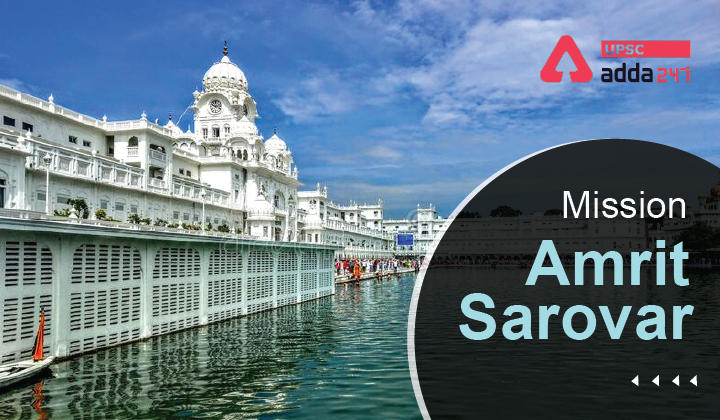Table of Contents
Amrit Sarovar Mission UPSC: Relevance
- GS 2: Conservation, environmental pollution and degradation, environmental impact assessment.
Mission Amrit Sarovar: Context
- Recently, Ministry of Rural Development has held a high-level meeting to review the progress of Mission Amrit Sarovar.
About Amrit Sarovar Mission
When was Amrit Sarovar launched?
- Mission on Amrit Sarovar was launched in April 2022 with a broad aim of conserving water for the future.
Amrit Sarovar Mission objective
- The Mission is aimed at developing and rejuvenating 75 water bodies in each district of the country as a part of celebration of Azadi ka Amrit Mahotsav.
- In total, it would lead to creation of 50,000 water bodies of a size of about an Acre or more.
- Each of these Amrit Sarovar will have area of 1 acre with a water holding capacity of 10,000 cubic meter.
Amrit Sarovar Technical partner
- Bhaskaracharya National Institute for Space Application and Geo-informatics (BISAG-N) has been engaged as technical partner for the Mission.
Convergence with other schemes
- The Mission works through the States and Districts, through refocusing of various schemes such as Mahatma Gandhi NREGS, XV Finance Commission Grants, PMKSY sub schemes such as Watershed Development Component, Har Khet Ko Pani besides States’ own schemes.
Mission Amrit Sarovar: Implementation
- The site of Amrit Sarovars will be approved by special Gram Sabha, which will also name Panchayat Partinidhi, who will on its behalf supervise development of Amrit Sarovar.
Mission Amrit Sarovar: People’s participation
- Peoples’ participation is the key to entire initiative, as it is meant to evoke collective spirit of the community.
Mission Amrit Sarovar: Participating ministries/ organisation
- Ministry of Rural Development (Dept. of Rural Development/ Dept. of Land Resources)
- Ministry of Jal Shakti (Dept. of Water Resources/ Dept. of Drinking Water & Sanitation)
- Ministry of Culture
- Ministry of Panchayati Raj
- Ministry of Environment, Forest & Climate Change
- Bhaskaracharya National Institute for Space Applications and Geo-informatics (BISAG-N)
Other measures taken to improve groundwater resources
- Jal Shakti Abhiyan (JSA): Launched in 2019 to improve water availability including ground water conditions in the water stressed blocks of 256 districts in India.
- Jal Shakti Abhiyan: Catch the Rain” (JSA:CTR): It has been launched with the theme “Catch the Rain – Where it Falls When it Falls” to cover all the blocks of all districts (rural as well as urban areas) across the country.
- Atal Bhujal Yojana: It is a Rs.6,000 crore Central Sector Scheme, for sustainable management of ground water resources with community participation.
- Master Plan for Artificial Recharge to Groundwater – 2020: It is a macro level plan prepared by the Central Ground Water Board. The plan envisages construction of about 1.42 crore rain water harvesting and artificial recharge structures in the country.
- National Aquifer Mapping and Management program (NAQUIM): It envisages mapping of aquifers, their characterization and development of Aquifer Management Plans to facilitate sustainable management of groundwater resources in the country.
- Other schemes: Artificial groundwater recharge/water harvesting works is also being supported MGNREGA and Prime Minister Krishi Sinchayee Yojana – Watershed Development component (PMKSY-WDC), ‘Surface Minor Irrigation (SMI) and Repair, Renovation and Restoration (RRR) of Water Bodies schemes’ a component of PMKSY.
Read current affairs for UPSC




 TSPSC Group 1 Question Paper 2024, Downl...
TSPSC Group 1 Question Paper 2024, Downl...
 TSPSC Group 1 Answer key 2024 Out, Downl...
TSPSC Group 1 Answer key 2024 Out, Downl...
 Cabinet Ministers of India 2024, New Cab...
Cabinet Ministers of India 2024, New Cab...







